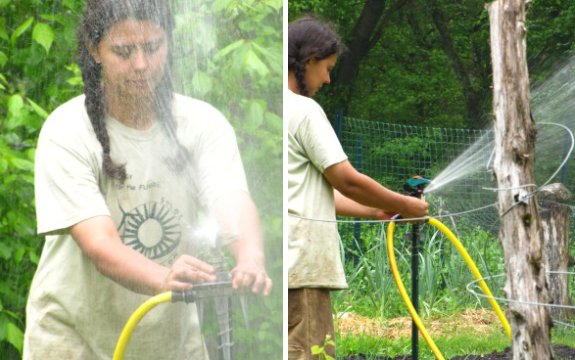
Sounds of summer

If I had to sum up our summer
season with one sound it would be the mechanical clatter and spray that
pulsate from these sprinklers on a hot day like today.
Want more in-depth information? Browse through our books.
Or explore more posts by date or by subject.
About us: Anna Hess and Mark Hamilton spent over a decade living self-sufficiently in the mountains of Virginia before moving north to start over from scratch in the foothills of Ohio. They've experimented with permaculture, no-till gardening, trailersteading, home-based microbusinesses and much more, writing about their adventures in both blogs and books.
Want to be notified when new comments are posted on this page? Click on the RSS button after you add a comment to subscribe to the comment feed, or simply check the box beside "email replies to me" while writing your comment.

Instead of using a filter, you could also use a settling basin. If you grow plants at the edge of that basin they could absorb nutrients from the water. Of course you'd have to muck it out sometimes, the period depending on the depth of the basin. But the sediment might be useful, e.g. as a fine clay.
Your thousand gallon tank probably isn't big enough and/or quiet enough to allow sufficient clearing.
If you fill a glass with turbid water (close off the top to prevent evaporation) and leave it undisturbed in a location where you can look through it, you can determine roughly how many days of still water are required for all sediment to settle. This depends on the size and density of the sediment.
If you add water to the tank by pumping it in through a hose I'd guess you'd shake up a lot of the sediment again. Purpose-built settling tanks are made as to only create a very low and constant velocity accross the tank to allow sediments to settle.
For better filtration one can use a sand filter. Here in the Netherlands sand dunes and other naturally occuring sand formations have been used as natural filters for a long time.